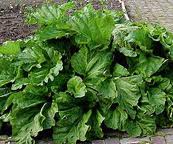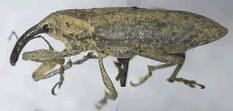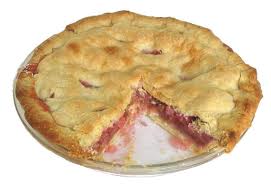Rhubarb (Rheum rhabarbarum L.)
 Rhubarb (Rheum rhabarbarum L.) is a cool season, perennial vegetable, grown for its leafstalks that have a unique tangy taste used for pies and sauces.
Rhubarb (Rheum rhabarbarum L.) is a cool season, perennial vegetable, grown for its leafstalks that have a unique tangy taste used for pies and sauces.
Rhubarb was cultivated in the Far East more than 2,000 years ago. It was initially grown for medicinal purposes, and not until the 18th century was it grown for culinary use in Britain and America. Rhubarb is as hardy as a weed. It is a very beautiful garden plant, with huge extravagant, lush green leaves and pink or red stalks.
This crop requires winter temperatures below 40 degrees F to break dormancy and stimulate spring growth; and summer temperatures averaging less that 75 degrees F for vigorous vegetative growth. Rhubarb is hardy in USDA Zone 4, and worth trying in Zone 3. The tops are usually killed in the first heavy freeze in the fall, but roots survive and produce new tops the following spring. While the leafstalks are edible, the leaves themselves contain oxalic acid and should not be eaten.
Recommended Varieties
Different varieties have varying levels of sourness and fibrousness, and they also vary in color from almost pure green to almost pure red. Usually the skin is more or less red, while the flesh color varies from pale to darker green. Flavor is not correlated with color. Redder varieties are particularly desirable for pies, because the color of the filling is more attractive than the grayish color of cooked green varieties.
Plant stature and vigor also vary among varieties. In general, greener varieties are more vigorous and have longer stalks than red varieties.
Only the long, thick leaf petioles, the “stalks,” are edible.
Canada Red (long, thick stalks, extra sweet)
Rhubarb Canadian Red 5 roots
by Rhubarb Canadian Red 5 roots
Rhubarb Canadian Red 5 roots Sweet flavor with bright red stems. Easy to grow. Size #1 Division. Hardiness Zone: 2 - 8 Color: Red Size: #1 Division If your ground can be dug you can plant these right now, and have fruit this summer. Give 1 to two weeks to ship these upon ordering, usually its only a week. I do not ship out of the United States. I do combine shipping if you order more than one item and I can combine them in the same box, I will refund you the difference in the shipping that you pay. This will save you alot in shipping.
MacDonald (tender skin; brilliant red)
Macdonald Red Rhubarb Plant - The Pie Plant! - Hardy
by Hirts: Vegetable
-
Large, tender stalks and has vibrant red color
-
Easy to grow. Lasts forever
-
Loves the sun
-
Hardy in zones 5-8
-
Immediate shipping. Growing in 5" pots
We have selected this strain for its excellent production for commercial growers and home gardeners. This very vigorous, upright growing strain produces large, tender stalks and has vibrant red color.
Victoria (shaded with red)
Victoria Red Rhubarb 4 Plants -Perennial- Easy to grow
by Hirts: Vegetable
-
This is a standard crop variety of Rhubarb
-
One of the largest and most productive varieties
-
The stalks are a deep crimson red with a touch of green on the inside
-
Immediate shipping in 2 1/2" pots. Dormant shipping in winter.
This is a standard crop variety of Rhubarb. One of the largest and most productive varieties. The stalks are a deep crimson red with a touch of green on the inside. The taste has a bit of a wine flavor to it. First recorded in 1837 in England.
Planting Rhubarb
Rhubarb should be planted at the end of one side of the garden where it will not be disturbed since it may be productive for five years or more. A half-dozen plants will provide enough rhubarb for a family of four. Plant or divide rhubarb roots in early spring while the plants are dormant. Planting seeds is not recommended except in extremely southern areas of the United States.
Each plant will require approximately one square yard of space. Loosen the soil to a depth of 10 inches. For each plant, prepare the soil by adding 3 to 4 inches of compost or well-aged manure and a handful of fertilizer that is relatively high in phosphorus and potassium, such as 5-10-10.
Starting New Plants - Plant the roots with the crown bud 2 inches below the surface of the soil. Space the roots 36 to 48 inches apart. Good garden drainage is essential in growing rhubarb. Planting on raised beds ensures against rotting of the crown. Working plenty of well-rotted manure or compost into the rhubarb bed before planting greatly increases production.
Dividing Old Plants - Old roots may be dug and divided to make new plantings. Cut the roots into four to eight pieces. Each piece must have at least one strong bud. To improve vigor and leaf size, many gardeners divide the old plants and establish a new planting after at least 5 years of full harvest. Plantings older than this tend to begin crowding themselves out. Dig the roots of the most vigorous, healthy plants to establish a new bed the spring before the old planting is to be discarded.
Cover the crowns with no more than an inch or two of soil. Planting rhubarb crowns too deep will delay production. Press the soil firmly around the roots and water well. As soil and air temperatures begin to warm, new buds will push up through the soil.
Once the plants are up and growing, the addition of a 3- to 4-inch layer of clean straw, compost, or similar mulching material will help control weeds and conserve soil moisture for plant growth and development.
Care of Rhubarb
Watering
Irrigate during extended dry periods.
Fertilizing
Apply a complete garden fertilizer before growth begins in the spring and side-dress with a high-nitrogen fertilizer in late June. An application of manure or compost is beneficial in late fall or early winter. Do not cover the crowns.
Mulch
Except in poorly drained sites, organic mulches help moderate soil temperature and moisture.
Pruning
If seedstalks and flowers develop during the spring and summer, cut them from the base of the plant as soon as they appear and discard them.
Over-Winter
After the tops are dead and the ground is frozen, the plants can be covered with 2 to 3 inches of straw mulch. Remove one-half of the mulch before growth starts in the spring.
Rhubarb leaves may be added to your compost pile. While the leaves contain oxalic acid, this rapidly decomposes in the compost pile and has no negative effect on the quality of the compost.
Harvesting Rhubarb
 Do not harvest rhubarb during the first year of planting. Newly set plants need all their foliage to build a strong root system. Stalks may be harvested for 1 or 2 weeks during the second year and for 8 to 10 weeks (a full harvest season) during the third and subsequent years.
Do not harvest rhubarb during the first year of planting. Newly set plants need all their foliage to build a strong root system. Stalks may be harvested for 1 or 2 weeks during the second year and for 8 to 10 weeks (a full harvest season) during the third and subsequent years.
Harvest in the fall only when the plants are to be discarded the next season.
To pick rhubarb, hold the stalk firmly, pull, and twist. Using a knife to cut the stalks from the plant is not recommended. The knife can carry diseases from plant to plant, and the remnant of the stalk serves as a point of entry for other pests. But immediately upon harvesting, use a knife to trim the leaves from the stalks and discard. They are toxic, and leaving them on can speed wilting of the stalks. Stop harvesting leafstalks when the plant begins to produce slender stalks, a sign that its reserves are low.
The leaf blades contain large amounts of oxalic acid and should not be eaten.
To keep the plants healthy, vigorous and producing well, remove only about one-third of the leaves from a plant at any one time.
For storage, first trim and discard the leaves. The freshly harvested stalks can be kept in the refrigerator, unwashed and wrapped tightly in plastic, for up to three weeks.
Occasional Problems of Rhubarb
 Rhubarb curculio, a snout beetle, bores into the stalks, crowns and roots of rhubarb plants. It also attacks wild dock, a weed that is prevalent in many areas of the country. Treat the base of plants with a suggested insecticide. Burn badly infected rhubarb plant parts in July after the beetles have laid their eggs.
Rhubarb curculio, a snout beetle, bores into the stalks, crowns and roots of rhubarb plants. It also attacks wild dock, a weed that is prevalent in many areas of the country. Treat the base of plants with a suggested insecticide. Burn badly infected rhubarb plant parts in July after the beetles have laid their eggs.
Cooking Rhubarb
 Rhubarb requires the addition of sugar to combat its extreme tartness. The early pink-stems seem to produce the best flavor for cooking. Rhubarb, or "the pie plant," is often considered a fruit, but it is actually a vegetable (leaf stem). It is prized for it's mouth-puckering tartness which adds zest to pies, tarts, cold soups, jam, and a host of other desserts.
Many other flavors are flattered by the sourness of rhubarb. In the US it is most often teamed up with strawberries and baked into pies and tarts. A typical English preparation would use ginger, while the French may puree it into a sauce and serve it with fish.
Rhubarb requires the addition of sugar to combat its extreme tartness. The early pink-stems seem to produce the best flavor for cooking. Rhubarb, or "the pie plant," is often considered a fruit, but it is actually a vegetable (leaf stem). It is prized for it's mouth-puckering tartness which adds zest to pies, tarts, cold soups, jam, and a host of other desserts.
Many other flavors are flattered by the sourness of rhubarb. In the US it is most often teamed up with strawberries and baked into pies and tarts. A typical English preparation would use ginger, while the French may puree it into a sauce and serve it with fish.
When cooking fresh rhubarb, use a vegetable peeler to remove any brown or scaly spots. Peeling the entire stalk is unnecessary, simply trim the ends and wash and dry the stalks.
Always use a non-reactive pan for cooking this high acid plant. Use anodized aluminum, stainless steel, Teflon coated aluminum or enamel-coated cast iron cookware.
Rhubarb cooked in reactive metal pots (aluminum, iron, and copper) will turn an unappetizing brown color. Metal ions flaking off the pan will interact with acids in the fruit to form brown compounds that darken both the pan and the rhubarb.
Recipe for Rhubarb Strawberry Topping
This sauce is excellent as a topping for ice cream, pancakes, waffles, pound cake, and a bowl of fresh fruit, gingerbread or yogurt. It will keep in the refrigerator for up to 4 days.
10 stalks rhubarb, trimmed and cut into 1-inch pieces
4 cups hulled, quartered strawberries
1 1/2 cups sugar
1 cup orange juice
Zest of one orange, grated
Zest of one lemon, grated
1/2 teaspoon vanilla extract
1. In a large heavy saucepan, combine all ingredients and stir well. Bring to a boil over medium-high heat.
2. Reduce heat and simmer for 10 to 12 minutes, skimming of foam as it collects.
3. Remove from heat and allow it to cool to room temperature. Cover and refrigerate. Serve cold or warm. Reheat if desired. Keeps for 4 days in the refrigerator. Makes 8 cups.
Home Preservation
To freeze: Chop into 1/2-inch pieces, spread them on a sheet pan and place in the freezer. Once frozen, slide the rhubarb into heavy-duty plastic freezer bags. Seal tightly and put back into the freezer. Packed this way, rhubarb will keep for up to six months, and can be measured from the freezer bag.
 Rhubarb (Rheum rhabarbarum L.) is a cool season, perennial vegetable, grown for its leafstalks that have a unique tangy taste used for pies and sauces.
Rhubarb (Rheum rhabarbarum L.) is a cool season, perennial vegetable, grown for its leafstalks that have a unique tangy taste used for pies and sauces.  Rhubarb requires the addition of sugar to combat its extreme tartness. The early pink-stems seem to produce the best flavor for cooking. Rhubarb, or "the pie plant," is often considered a fruit, but it is actually a vegetable (leaf stem). It is prized for it's mouth-puckering tartness which adds zest to pies, tarts, cold soups, jam, and a host of other desserts.
Many other flavors are flattered by the sourness of rhubarb. In the US it is most often teamed up with strawberries and baked into pies and tarts. A typical English preparation would use ginger, while the French may puree it into a sauce and serve it with fish.
Rhubarb requires the addition of sugar to combat its extreme tartness. The early pink-stems seem to produce the best flavor for cooking. Rhubarb, or "the pie plant," is often considered a fruit, but it is actually a vegetable (leaf stem). It is prized for it's mouth-puckering tartness which adds zest to pies, tarts, cold soups, jam, and a host of other desserts.
Many other flavors are flattered by the sourness of rhubarb. In the US it is most often teamed up with strawberries and baked into pies and tarts. A typical English preparation would use ginger, while the French may puree it into a sauce and serve it with fish. 
 Do not harvest rhubarb during the first year of planting. Newly set plants need all their foliage to build a strong root system. Stalks may be harvested for 1 or 2 weeks during the second year and for 8 to 10 weeks (a full harvest season) during the third and subsequent years.
Do not harvest rhubarb during the first year of planting. Newly set plants need all their foliage to build a strong root system. Stalks may be harvested for 1 or 2 weeks during the second year and for 8 to 10 weeks (a full harvest season) during the third and subsequent years.  Rhubarb curculio, a snout beetle, bores into the stalks, crowns and roots of rhubarb plants. It also attacks wild dock, a weed that is prevalent in many areas of the country. Treat the base of plants with a suggested insecticide. Burn badly infected rhubarb plant parts in July after the beetles have laid their eggs.
Rhubarb curculio, a snout beetle, bores into the stalks, crowns and roots of rhubarb plants. It also attacks wild dock, a weed that is prevalent in many areas of the country. Treat the base of plants with a suggested insecticide. Burn badly infected rhubarb plant parts in July after the beetles have laid their eggs.
